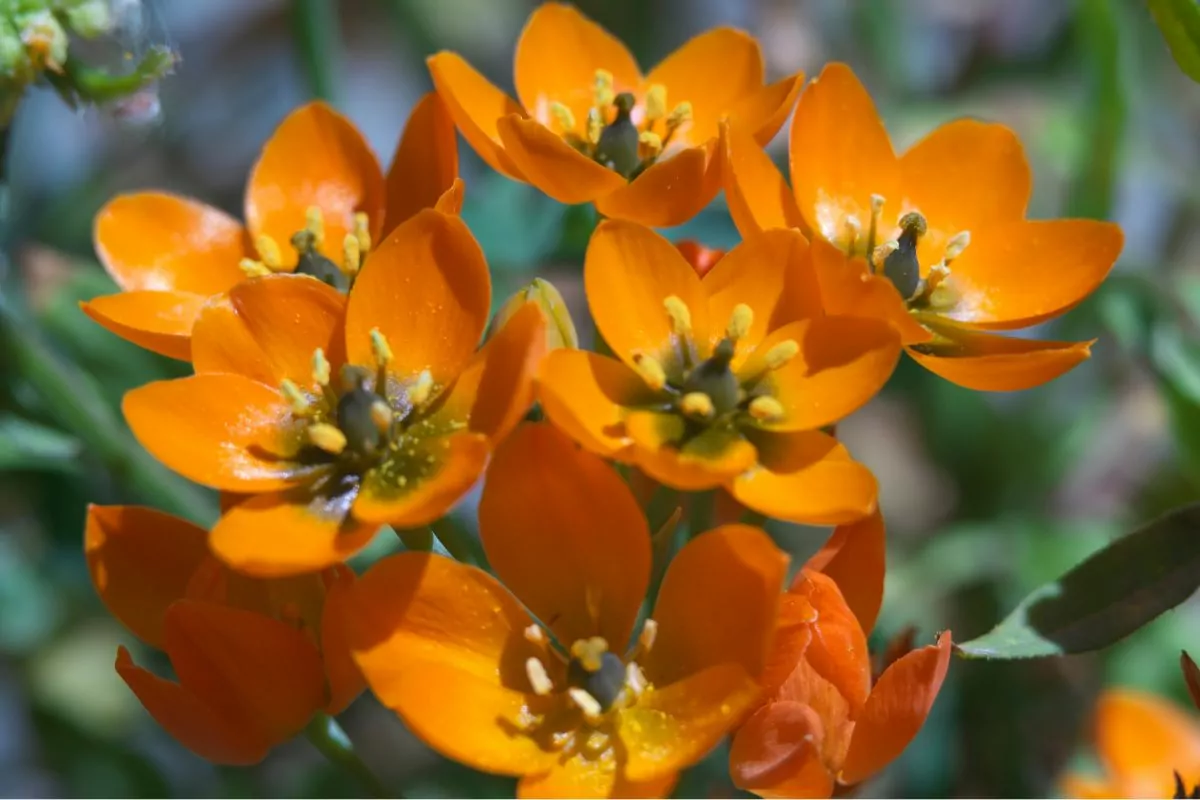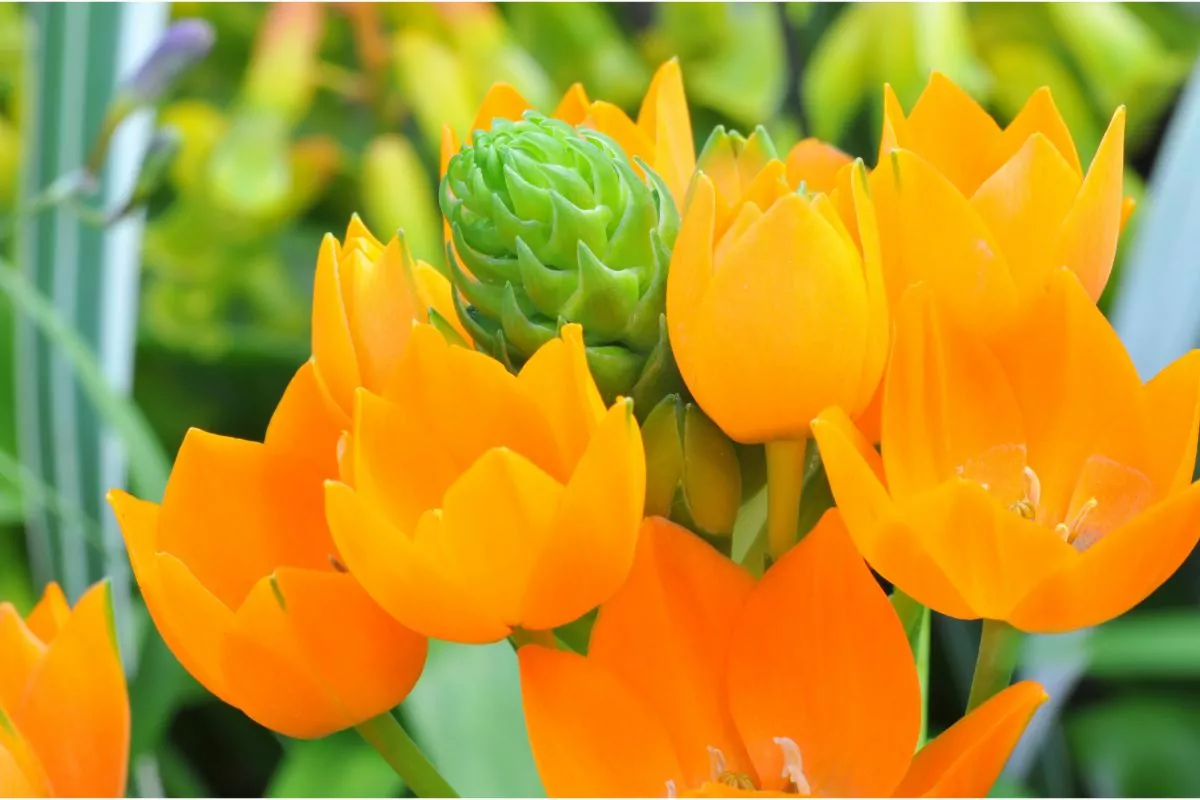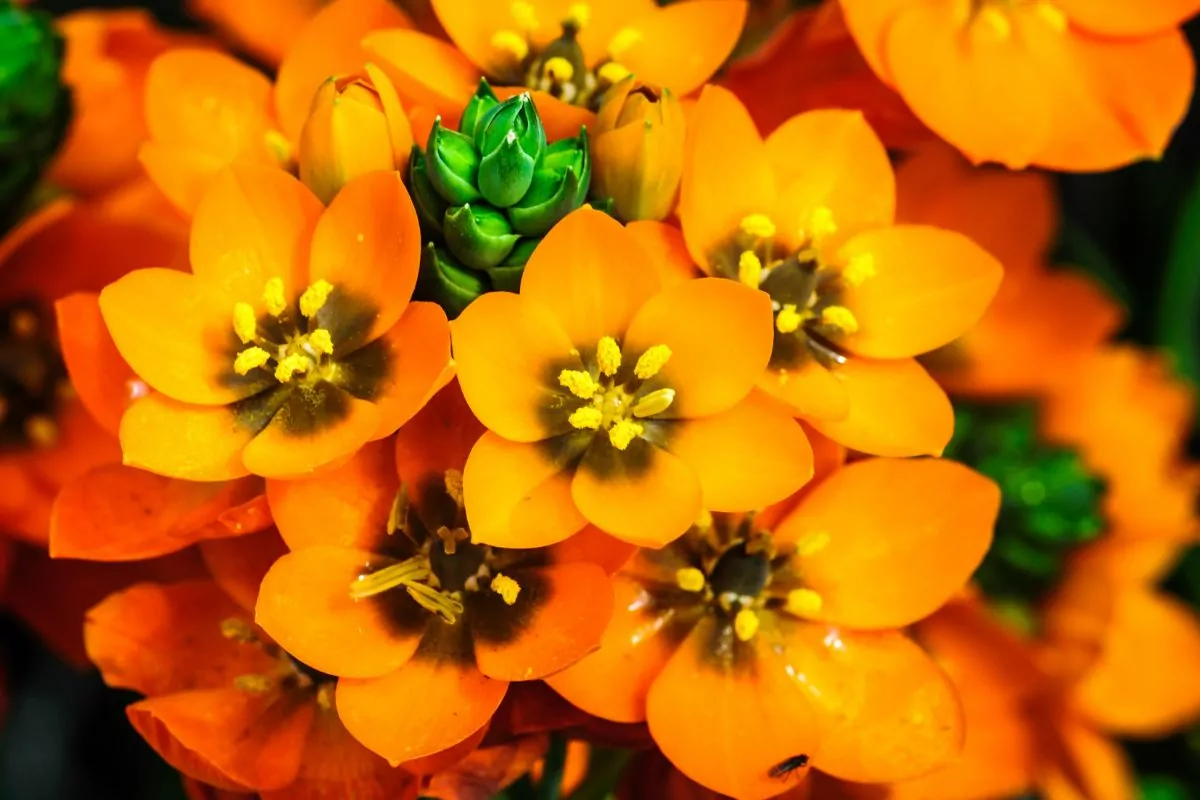Ornithogalum Dubium, commonly known as the Sun Star, is a popular flowering plant that belongs to the family Asparagaceae. This plant is widely cultivated around the world for its beautiful and brightly colored flowers that resemble miniature suns.

In this article, we will explore everything you need to know about the Ornithogalum Dubium, including its characteristics, care requirements, propagation methods, and its natural habitat.
Whether you are a seasoned gardener or a beginner looking to add some color to your home, this guide will provide you with all the information you need to successfully grow and care for this stunning plant.
What Is The Ornithogalum Dubium?
As mentioned, this flowering plant belongs to the family Asparagaceae whilst also being a perennial herb that produces bright orange, star-shaped flowers with a yellow center.
The plant typically grows to be around 30-60cm tall and blooms in the summer and autumn months.
Ornithogalum Dubium is commonly grown as an ornamental plant in gardens and is also often used in floral arrangements due to its striking color and unique appearance.
As well as that, the plant is relatively easy to grow and care for, making it a popular choice for gardeners and plant enthusiasts.
The Habitat Of The Ornithogalum Dubium
Ornithogalum Dubium is native to South Africa, where it grows in dry, rocky habitats such as scrublands and grasslands. The plant thrives in warm, dry conditions and can tolerate high temperatures and low humidity.
In its natural habitat, Ornithogalum Dubium grows in well-draining soils, often in areas with low rainfall. The plant is adapted to dry conditions and has a deep root system that allows it to access water from deep in the soil.
In cultivation, Ornithogalum Dubium can be grown in a variety of settings, including in containers or in the ground. The plant prefers well-draining soil that is slightly acidic to neutral, with a pH range of 6.0 to 7.0.
It needs plenty of light but should be protected from direct sunlight during the hottest part of the day and if grown indoors, the plant should be placed near a sunny window or under artificial lighting.
Overall, Ornithogalum Dubium is a hardy plant that is well-suited to warm, dry conditions. It can thrive in a variety of soil types and settings, as long as it has access to adequate light and water.
How To Care For Ornithogalum Dubium

If you’re planning to bring one of these beautiful plants home, you will need the right know-how so that you can care for it appropriately.
With this in mind, let’s go through the key points that you need to know to help you learn how to best care for the Ornithogalum Dubium!
Light Requirements
Ornithogalum Dubium plants require bright, indirect light to grow and bloom well. They also need a minimum of six hours of sunlight each day, which can be achieved by placing them near a sunny window, on a sunny balcony, or outdoors in a well-lit location.
That being said, make sure that you avoid exposing the plant to direct sunlight, as it can burn the leaves and flowers.
If your Ornithogalum Dubium plant is not getting enough light, it may become leggy and produce fewer flowers.
On the other hand, if it is getting too much light, the leaves may turn yellow or brown, and the flowers may wither quickly. In such cases, you can move the plant to a brighter or less sunny location, depending on its needs.
If you are growing your Ornithogalum Dubium plant indoors, you may need to supplement its light requirements using artificial light sources such as fluorescent or LED grow lights.
These lights can provide the necessary amount of light that the plant needs to grow and bloom properly. You can keep the lights on for 12-16 hours each day, depending on the light intensity and the plant’s specific needs.
Watering Requirements
Proper watering is essential for the health of Ornithogalum Dubium plants. Overwatering or underwatering can lead to root rot or dehydration, which can damage or kill the plant.
Water your Ornithogalum Dubium plant once a week, or when the soil is dry to the touch. During the growing season (spring and summer), the plant may require more frequent watering.
However, during the dormant season (fall and winter), the plant may require less frequent watering.
Water the soil around the base of the plant, avoiding the leaves and flowers. Use room temperature water, and avoid using chlorinated water, as it can harm the plant. You can use a watering can, a spray bottle, or a hose to water the plant as gently as possible and keep it happy.
You will also need to ensure that the pot has drainage holes to allow excess water to drain out of the soil. Avoid leaving the plant in standing water, as this too can lead to root rot.
Humidity
Ornithogalum Dubium plants prefer moderate to high humidity levels, similar to their native habitat in South Africa. However, they can tolerate lower humidity levels as well.
Grouping your Ornithogalum Dubium plant with other plants can help increase the humidity levels around it. This is because plants release moisture through a process called transpiration, which can create a microclimate of higher humidity around them.
One top tip is to place a tray of pebbles filled with water under the plant pot can help increase humidity levels. The water will evaporate, creating a humid environment around the plant.
You can also use a room humidifier, as this will help increase the overall humidity levels in the room where the plant is located. This can benefit not only the plant, but also your own health and well-being!
Misting the leaves of your Ornithogalum Dubium plant with water can also help increase humidity levels around the plant. However, be careful not to overdo it, as excessive misting can lead to fungal diseases.
Lastly, consider using a humidity meter, as this can help you monitor the humidity levels around your Ornithogalum Dubium plant.
The ideal humidity level for this plant is around 50-60%. If the humidity level is lower than this, you may need to use one of the above methods to increase it.
Temperature
Ornithogalum Dubium plants prefer warm temperatures and cannot tolerate frost or freezing temperatures.
To be more specific, these plants tend to fare best in temperatures between 60-75°F (15-24°C). Avoid exposing the plant to temperatures below 50°F (10°C) as this can cause damage or death to the plant.
Place your Ornithogalum Dubium plant in a warm and well-ventilated location, away from drafty areas or sources of heat, such as radiators or air conditioning units.
If you are planting your Ornithogalum Dubium plant outdoors, make sure to do so during the spring or summer months when the temperatures are warm.
Also, you will want to make sure to protect the plant from frost by covering it with a blanket or moving it indoors during cold spells.
Avoid exposing your Ornithogalum Dubium plant to sudden temperature changes, as this can shock the plant and cause damage.
For example, avoid placing the plant near a door or window that opens frequently, as this can expose the plant to sudden cold drafts.
Remember that humidity and temperature are closely related, and high humidity levels can make the temperature feel hotter than it actually is. Therefore, maintaining appropriate humidity levels around the plant can also help regulate the temperature.
Soil Requirements
A good soil mixture for Ornithogalum Dubium plants consists of a combination of peat moss, perlite, and sand. This mixture provides good drainage, while also retaining enough moisture to keep the plant healthy.
The ideal pH level for Ornithogalum Dubium plants is between 6.0-7.5. Test your soil’s pH level using a soil testing kit, and if necessary, adjust it by adding lime or sulfur.
When it comes to repotting, it is best to repot your Ornithogalum Dubium plant every two to three years, or when the roots outgrow the pot. Use fresh soil and a slightly larger pot to accommodate the growing roots.
Don’t forget that proper watering is important to prevent soil from becoming too compacted and to ensure good drainage. Water the plant when the soil surface feels dry to the touch, but avoid overwatering, as this can lead to that dreaded root rot.
Fertilizer
Ornithogalum Dubium plants do not require a lot of fertilizer, but providing the plant with the right amount of nutrients can help promote its growth and health.
These plants will need fertilization once every two to three months during the growing season (spring and summer). You can reduce or stop fertilization during the dormant season (fall and winter).
Use a balanced, water-soluble fertilizer with equal amounts of nitrogen, phosphorus, and potassium (N-P-K). You can also use a slow-release fertilizer that provides nutrients over a longer period.
Dilute the fertilizer according to the manufacturer’s instructions. Make sure not to overdo it, as over-fertilizing can damage the plant and lead to salt buildup in the soil.
Apply the fertilizer directly to the soil, taking care to avoid getting it on the leaves. Water the plant thoroughly after applying the fertilizer to help distribute it evenly throughout the soil.
If you prefer organic options, you can use compost or well-rotted manure instead of synthetic fertilizer. Be sure to avoid using fresh manure though, as it can burn the plant roots.
Pruning

Ornithogalum Dubium plants do not require regular pruning. However, you can trim any dead or yellowing leaves to keep the plant looking neat and healthy.
Remove spent flowers or blooms by cutting them off at the base of the stem. This will encourage the plant to produce new flowers and prevent the plant from wasting energy on producing seeds.
If you notice any yellow or brown leaves on the plant, remove them by cutting them off at the base of the stem, as this will aid with the prevention of the spread of any diseases or pests that may be affecting the plant.
If your Ornithogalum Dubium plant is growing too tall or leggy, you can trim it back by cutting off the top part of the stem to encourage it to produce new growth and help improve the plant’s overall appearance.
Pruning is best done in the spring or summer when the plant is actively growing. Avoid pruning during the dormant season, as this can damage the plant and stunt its growth.
To get the most out of your pruning, use a clean, sharp pair of pruning shears or scissors to avoid damaging the plant. Disinfect the tools with rubbing alcohol before and after use to prevent the spread of any diseases.
Propagation
When we discuss propagation, we are referring to the process of creating new plants from existing ones. This process involves taking a part of a plant, such as a stem, leaf, or seed, and using it to grow a new plant.
There are several methods of propagation, including seed propagation, division, and cuttings. Each method requires different techniques and conditions, but the goal is always the same: to produce a new plant that is genetically identical to the parent plant.
Ornithogalum Dubium plants can be propagated through several methods including offsets, division, and seeds. Let’s take a closer look at each method a little more closely.
Offsets
These plants produce offsets, or baby plants, that grow from the base of the parent plant. Wait until the offsets are at least one-third the size of the parent plant before attempting to propagate them.
Remove the offset from the parent plant with a clean, sharp knife and plant it in a pot with well-draining soil. Water the plant thoroughly and place it in a bright, indirect light.
Division
You can also propagate your Ornithogalum Dubium plant through division. Wait until the plant has finished flowering and is dormant before attempting to divide it.
Carefully remove the plant from the pot and separate the roots and bulbs. Plant the individual bulbs in separate pots with fresh soil and water thoroughly.
Seeds
The plants can also be propagated from seeds, although this method can be challenging.
Collect the seeds when the seed pods are dry and brown. Plant the seeds in a pot with well-draining soil, and keep the soil moist.
Place the pot in a warm, bright location, but avoid direct sunlight. The seeds should germinate in 2-3 weeks.
Provide appropriate care to the newly propagated plants by placing them in bright, indirect light, and keeping the soil moist but not waterlogged. Make sure to wait until the plant is established before fertilizing.
Pests And Diseases
Thankfully, these plants are generally resistant to pests and diseases, but they can still be affected by some common issues.
Here are some pests and diseases that can affect your Ornithogalum Dubium plant, along with some tips on how to prevent and treat them.
Spider Mites
These tiny pests can suck the sap from the leaves of the plant, causing yellowing and wilting.
To prevent spider mites, keep the plant well-hydrated and mist the leaves regularly. If spider mites are present, wipe the leaves with a damp cloth or spray them with a mixture of water and dish soap.
Mealybugs
These pests are small, white insects that produce a white, cotton-like substance on the plant. They can cause yellowing and wilting of the leaves.
To keep mealybugs away, ensure that the plant is well-hydrated and free of dust. If mealybugs do appear, wipe the leaves with a damp cloth or spray them with a mixture of water and dish soap as you would with spider mites.
Root Rot
This is a common disease that occurs when the plant’s roots are overwatered or the soil is too dense and waterlogged.
To prevent root rot, make sure the plant is potted in well-draining soil and that the pot has drainage holes. Water the plant only when the top inch of soil is dry.
Leaf Spot
This is a fungal disease that appears as brown or black spots on the leaves of the plant.
To prevent leaf spot, avoid getting the leaves wet when watering and make sure the plant has good air circulation. If leaf spot is present, remove the affected leaves and avoid getting water on the leaves when watering.
Scale Insects
These pests are small, round insects that can appear on the leaves or stems of the plant. They can cause yellowing and wilting of the leaves.
To stop scale insects in their tracks, keep the plant well-hydrated and free of dust. If scale insects are present, wipe the leaves with a damp cloth or spray them with a soap and water mix, as you would with spider mites and mealybugs.
Final Thoughts
Ornithogalum Dubium is a beautiful and easy-to-care-for plant that is perfect for any indoor or outdoor garden. With its bright orange flowers and slender green leaves, it is a popular choice among gardeners and plant enthusiasts alike.
As long as you provide the proper care to the plant- such as planting it in well-draining soil, providing it with plenty of sunlight, and keeping it well-watered but not overly watered-, the Ornithogalum Dubium is sure to be a wonderful addition to your plant collection that you can enjoy- with a bit of effort- year after year thanks to its stunning blooms.
Hopefully, our guide has offered enough information to make you feel confident enough to get started with the Ornithogalum Dubium in your garden or indoor plant habitat!
- Interesting Flowers That Start With A - July 21, 2023
- Interesting Flowers Beginning With H - July 21, 2023
- 14 Fascinating Flowers That Begin With C - July 20, 2023
